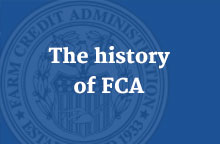Frequently Asked Questions
Click on a category below for FAQs on the respective topic.
General questions about FCA Risk identification Similar entity reporting Flood insurance Borrower rights Collateral evaluations Disclosure and reporting rule Governance changes in 2006 Risk-weighting HVCRE exposuresCollateral evaluations
-
Collateral evaluation requirements and internal controls
-
Collateral appraisal requirements
-
Appraisal exemptions for business loans and abundance of caution
-
Collateral valuation requirements
-
Determining market value
-
Independence requirements
-
Transaction value
Note: For more information, please see the references from which these FAQs were formed.
Collateral evaluation requirements and internal controls
1. What are collateral evaluations and when are they required?
When real, personal, or intangible property is taken as collateral for a loan or is the subject of a lease, an evaluation of the property shall be performed in accordance with FCA’s collateral evaluation regulations and the institution’s policies and procedures. In FCA’s collateral evaluation regulations, the term “evaluation” applies to either a collateral valuation or a collateral appraisal. An appraisal is a written statement of opinion on the market value of a property; a valuation is an estimate of value for a property.
2. Who is a qualified evaluator?
A qualified evaluator is an individual who is competent, reputable, impartial, and has demonstrated sufficient training and experience in evaluating property of the type that is the subject of the collateral evaluation.
3. Do the collateral evaluation regulations require the use of specific underwriting loan-to-value ratios?
The collateral evaluation regulations do not require the use of specific underwriting ratios except as required by statute (85 percent loan to value on long-term real estate loans). An institution may include industry-established norms and value guides in its internal guidelines. While FCA does not require the use of such information, the Agency does expect the institution to document the sources of such information if it is used to establish and support a market value.
4. What are the time frames for conducting new or updated collateral evaluations?
The regulations do not establish specific time frames for conducting new or updated collateral evaluations. It is the responsibility of the institution to monitor market conditions and trends, loan risk, and collateral conditions to appropriately determine the frequency for performing both new and/or updated valuations or appraisals. The regulations provide basic criteria for the completion of a collateral evaluation (appraisal or valuation), such as when a credit decision is made and new (additional) funds are approved or the terms and conditions of the credit are significantly changed.
5. Are institutions required to have collateral evaluation policies and procedures in place?
Yes. FCA’s collateral evaluation regulations require institutions to adopt policies if the institution engages in lending or leasing activities that are secured by collateral. The regulations provide a basic framework for policies, but it is an institution’s responsibility to address (1) the timing and frequency of new or updated collateral evaluations and (2) the level of detail each type of evaluation must have to support credit decisions. It is also the institution’s responsibility to set forth the qualification requirements for evaluators.
Collateral appraisal (Unified Standards of Professional Appraisal Practice (USPAP)) requirements
6. When is an appraisal required?
Generally, an appraisal is required when real estate is taken as security for a loan and the transaction value is over $250,000. Our rule at § 614.4260(c) provides seven exceptions to the requirement for an appraisal and instead accepts valuations to determine collateral values.
7. Are specific forms or formats required for developing and documenting appraisals?
The regulations do not require the use of specific forms or formats but rather describe the nature of the content and depth of information to be developed and documented. While the regulations provide basic requirements and expectations for the development and documentation of real property appraisals, they do allow some flexibility. This flexibility should be addressed within the institution’s policies and procedures.
8. Who may perform collateral appraisals?
Real estate-related financial transactions with values over $250,000 may be performed by either a qualified State-licensed real estate appraiser or a State-certified real estate appraiser. However, if the transaction value exceeds $1.0 million, the appraisal may only be performed by a State-certified real estate appraiser.
An appraiser should have the appropriate knowledge and experience needed to perform appraisals for the type of property that is being taken as collateral for a loan or is the subject of a lease. A particular appraiser’s knowledge and experience may not be adequate to qualify the appraiser to complete all possible collateral evaluation assignments. For example:
- An individual who is a State-licensed residential appraiser may have no experience appraising commercial or agricultural property.
- An individual may be a State-certified general appraiser with extensive experience in urban commercial property appraisals but have no experience appraising agricultural properties.
- An appraiser with general agricultural appraisal experience may not be qualified to appraise a highly specialized or unique agricultural operation.
9. Must collateral evaluation reviews be conducted by State-licensed or State-certified appraisers?
Reviewers do not need to meet State certification or licensing requirements to review appraisals for technical issues, compliance with USPAP and/or FCA regulations, or the adequacy of the appraisal. However, to adjust an appraisal, the reviewer must meet the respective State certification or licensing requirements associated with that appraisal, comply with USPAP Standard 3 (Appraisal Review, Development, and Reporting), and have the appropriate expertise to make the adjustments. Also, the independence requirements of § 614.4255(b) continue to apply to System reviewers.
Appraisal exemptions for business loans and abundance of caution
10. What is considered a business loan under FCA regulations?
A business loan is a loan or other extension of credit to any corporation, general or limited partnership, business trust, joint venture, sole proprietorship, or other business entity (including entities and individuals engaged in farming enterprises). This definition is similar to the definition used by other Federal financial institution regulatory agencies.
11. When is a business loan exempt from a collateral appraisal?
A collateral appraisal must be completed on all loans over $1 million (USPAP-compliant), and loans of $1 million or less if the repayment source of the loan is from the sale or rental of the real estate. No appraisal is required for loans at or below $250,000. An institution may require USPAP-compliant appraisals on any or all other loans through its collateral policies.
For further guidance, see flowchart titled Business Loan Appraisal Exemption Considerations for Transactions Over $250,000.
12. Which transactions qualify for the abundance of caution exemption?
The “abundance of caution” exemption can be taken in circumstances where the collateral is not required by laws, regulations, or the institution’s policies, and a prudent lender would extend credit based on a borrower’s income and/or other collateral, absent the real estate. Moreover, the decision to extend credit was, in fact, based on other sources of revenue or collateral. If the loan amount, maturity date, or interest rate would need to be significantly adjusted by the exclusion of the additional real estate collateral, the transaction would likely not qualify for the abundance of caution exemption.
FCS institution personnel may find it helpful to consider the following scenario when making a determination regarding abundance of caution exemptions:
Would the same credit decision have been made under the same basic terms and conditions if the real property had not been offered as collateral? If so, the abundance of caution exemption can be applied and a valuation can be performed. If not, an appraisal must be completed.
Collateral valuation requirements
13. When is a collateral valuation required?
A collateral valuation is required in the case of personal and intangible property, as well as real property where an appraisal is not required. For example, a collateral valuation is required when
- the transaction value is $250,000 or less,
- the transaction value is a “business loan” that
- has a transaction value of $1.0 million or less and
- is not dependent on income derived from the sale or cash rental of real estate as the primary source of repayment and
- a real estate lien is taken in an abundance of caution.
14. Who can perform a collateral valuation?
A valuation may be performed by loan officers, accountants, auctioneers, grain and livestock buyers, equipment dealers, or other qualified individuals, provided they have the experience and education that the institution’s collateral evaluation policy requires.
Determining market value
15. What are the methods used in determining market value of collateral?
The collateral evaluation regulations recognize three basic approaches to valuing collateral:
- The sales-comparison approach
- The income-capitalization approach
- The cost approach
Real estate evaluations must consider all three approaches before assigning a market value. All other evaluations must follow institution policies but include the sales comparison approach. Under USPAP, an appraisal’s Scope of Work section must fully explain the approach(es) used to determine the market value.
16. Can any of the three basic approaches to valuing collateral be excluded?
All three approaches must be considered, but all three do not have to be used in developing the final market value. Any method not used in the final analysis must be fully explained and documented within the Scope of Work Statement and must be based on one of the following reasons:
- The market does not react to a specific method of valuation.
- There is limited supporting information to develop a reliable approach.
- The approach requires significant adjustments that limit its reliability
Under USPAP, the appraisal’s Scope of Work section should include more than a statement that the approach is not appropriate when excluding any one or more of the approaches to valuing the collateral.
17. What is the income-capitalization approach?
The income-capitalization approach is the procedure that values property by measuring the present value of the expected future benefits of property ownership. FCA’s collateral evaluation regulations identify two acceptable methods of deriving the income-capitalization value of the collateral:
- Capitalizing a single year’s income expectancy or an annual average of several years’ income expectancies at a market-based capitalization rate that reflects a specific income pattern, return on investment, and change in the value of the investment.
- Discounting the annual cash flows for the holding period and the reversion at a specified yield rate(s) that reflects market behavior.
The first method involves the establishment of a market-based capitalization rate, and the second method involves the discounting of future earnings based on a discount rate reflective of the market.
18. If market-based rates are not available for measuring the income-capitalization approach value, may this method be omitted from the appraisal report?
The lack of market-based rental rates is not a sufficient reason by itself for omitting the income-capitalization approach from an appraisal report. Appraisers and lending officials are obliged to pursue other available sources relevant to determining a property’s income-producing capacity, e.g., industry information, enterprise budgets, university or Government studies, information developed by recognized experts, and typical operator income and expense information.
19. How essential is the analysis of the real property’s income-producing capability?
While the income-capitalization approach is not the only means of assessing the inherent risk in collateral, it is believed to be one of the most reliable. Inadequate collateral risk measures will likely leave an institution unknowingly vulnerable to declines in real estate values that result from industry-wide distress, inordinate concentrations in specific commodities, or downturns in local economic conditions.
Use of the income-capitalization approach enhances an institution's ability to access and manage collateral risk properly. For example, low capitalization rates for real estate collateral may indicate a need to adjust the conditions under which a specific loan is made, while an aggregate analysis of loans with low capitalization rates on underlying collateral may indicate a need to adjust the institution's underwriting standards or portfolio management practices.
Regardless of the information source, § 614.4265 requires an analysis of the income-producing capacity on all real estate transactions exceeding $250,000.
20. May computer-based models be used in conducting collateral evaluations?
Yes. Both valuations and appraisals may be accomplished through the use of computer-based models. When used with homogenous data, a collateral value can be statistically determined. However, with the diversity of commodities in certain districts and developmental influences on property values, institutions need to ensure that sufficient data are available to statistically determine accurate collateral values. An independent validation process should be used to determine the appropriate application of computer-based models. For more information about the independent validation process, see FCA's Model Risk Management procedure in the Corporate Governance Examination Manual topic.
Independence requirements
21. What are the independence requirements for an institution’s officer or employee conducting collateral evaluations?
Section 614.4255(b) allows loan officers to perform collateral evaluation and complete the credit decision on a loan package as long as an institution's internal controls provide for either a prior approval or post review of the credit decision. The post review should, at a minimum, be completed in connection with an institution's internal credit review of a representative sample of a loan officer's credit decisions and related collateral evaluations. A more detailed review may be required if, on examination, FCA finds that such a sampling is not sufficient to adequately review a loan officer's credit decisions and related collateral evaluations.
22. What other independence requirements exist for individuals performing collateral evaluations?
Regulation § 614.4255(c) and (d) contain functional independence requirements specifically for real property appraisers, and § 614.4255(e) covers independence requirements for real estate appraisals supporting a loan and the decision to subsequently purchase the loan. The independence requirements for system personnel apply to any person who could be considered a qualified evaluator and is involved in the marketing, lending, or collection functions of the institution, has loan approval authority, or participates in the institution’s loan committee decisions or other credit decision process.
23. Is a lender required to contract for the completion of an external impact analysis when an environmental concern has been identified?
When an environmental concern is identified, it is the responsibility of the lending institution to ascertain its impact on the value of the collateral, as well as the financial viability of the borrower. Each institution must decide whether to contract for the completion of an external analysis taking into account prudent business concerns and safety and soundness considerations. An external impact expert may also be engaged by the borrower, or the seller of a property as long as the institution has access to the results for use in the credit decision.
Transaction value
24. What is the definition of a loan transaction value?
A loan transaction value is the amount of a loan, loan commitment, or other extension of credit. Consider the following example:
An existing borrower with loans outstanding of $1.1 million requests that the institution approve a new loan for $90,000 to be secured by real property already under lien (valued at $1.5 million). Even though the total indebtedness to the institution after the new loan request would be nearly $1.2 million, the transaction value associated with this request is $90,000.
However, if an institution makes a series of small loans, leases, or other credit transactions in a short time in order to circumvent the required minimum level, FCA may require those transactions to be aggregated. In such cases, FCA will look to the substance of the credit transactions, rather than the form, to determine the aggregation of such multiple credits.
Also see Determining Whether to Apply the Business Loan Appraisal Exemption to Transactions Over $250,000.
25. Is a real estate related transaction the same as that defined in FAQ #24?
No. For sales, leases, purchases, and investments in, or exchanges of real property, a transaction value is the market value of the property interest involved. The transaction value definition differs for real property sales, purchases, leases, and exchanges because there may be no associated loan and the only reasonable and reliable method of establishing a threshold level is to base it on the market value of the subject property.
References
- Collateral definitions: § 614.4240
- Collateral evaluation policies: § 614.4245
- Collateral evaluation standards: § 614.4250
- Independence requirements: § 614.4255
- Evaluation requirements: § 614.4260
- Real property evaluations: § 614.4265
- Personal and intangible property evaluations: § 614.4266
- Internal controls: § 618.8430
- Significant Asset Growth and Its Implications, FCA Informational Memorandum, February 9, 2007
- Collateral Evaluation Requirements and Frequently Asked Questions, FCA Informational Memorandum, April 21, 2008



